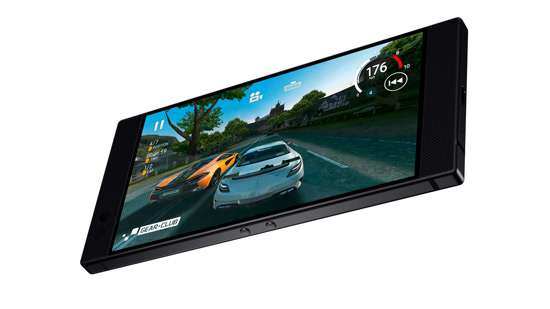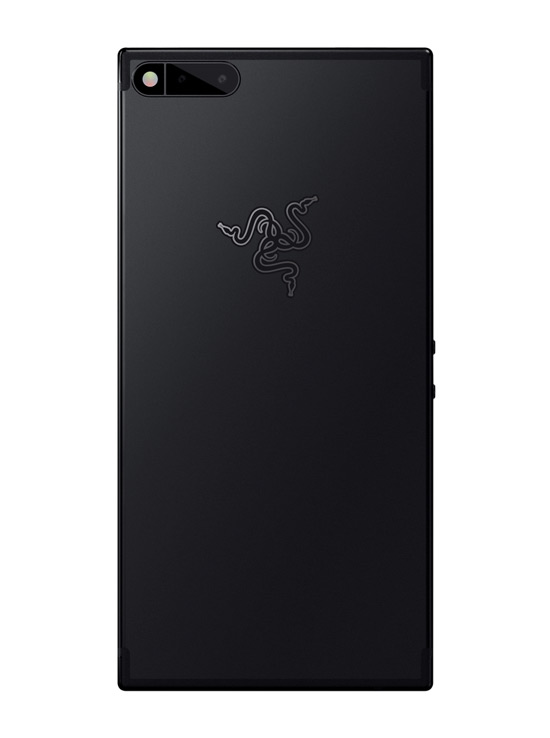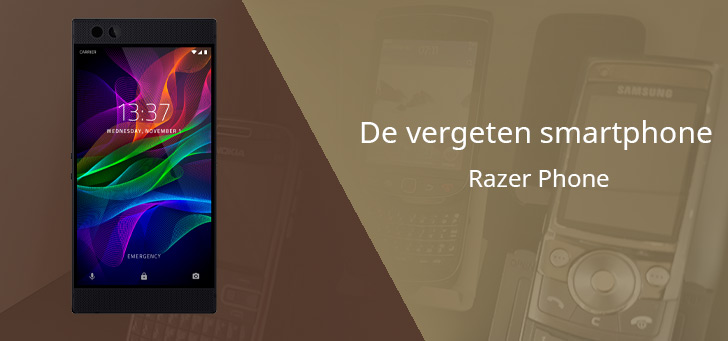The forgotten smartphone: Razer Phone
In ‘The forgotten smartphone’ we discuss many well-known and lesser-known smartphones from different years. Now we take you in an extended edition of ‘The forgotten smartphone’ and we tell you everything about the Razer Phone.
Contents
Razer Phone
Various gaming phones have already been featured in the section ‘the forgotten smartphone’. After the Nokia N-Gage and Sony Ericsson Xperia Play, today I want to focus on the Razer Phone. This device really started the race for the ultimate gaming phone. Every reason to consider the Razer Phone.
Razer is not an unknown name in the gaming community: the company has been producing and selling accessories for gamers for years, ranging from headphones and keyboards to microphones and laptops. Min-Liang Tan, the CEO of Razer, wanted to tap into a new segment: mobile gaming. That is not surprising when you consider that game developers made more than 100 billion dollars in 2016 with mobile games. Tan, of course, wanted to get a piece of that.
Razer knew a lot about gaming equipment. However, the manufacturer hadn’t eaten cheese from making smartphones. To bridge this knowledge gap, Nextbit was incorporated. You may know the company of the Nextbit Robin, the cloud-first smartphone that was presented at the beginning of 2016. From a commercial point of view, the Nextbit Robin was a flop, selling only a few thousand copies. Despite the disappointing sales figures, Tan saw a future for this mobile phone. In January 2017, the CEO saw his chance and bought Nextbit for an undisclosed amount.
Ten months after the acquisition, the Razer Phone was a fact. On November 1, 2017, Tan took the stage at the Science Museum in London to announce the Razer Phone. He presented the device as “the first smartphone for and by gamers”.
High refresh rate and razor-sharp sound
At first glance, the Razer Phone looks like a one-to-one copy of the Nextbit Robin. Nevertheless, Razer managed to put its own stamp on the design in various areas. The Razer Phone has four features that make it a real gaming phone.
First of all, it has a display with a high refresh rate. The average telephone refreshes the image at a rate of 60 hertz. The Razer Phone does that at 120 hertz. Combined with Razer’s UltraMotion technology, this ensured that the screen reacts immediately as soon as you touch it. With that, Razer put an end to stuttering, tearing, ghosting and lag, something that avid gamers can kill. Before that, the game had to support this refresh rate. With games like Tekken, Vain Glory, Arena of Valor, Lara Croft GO and Titanfall Assault that was no problem.
Second, Razer has done its best to deliver a top notch sound. The Razer Phone has two front-facing stereo speakers with Dolby Atmos on the front. As a result, no sound is lost and everything sounds razor-sharp. The amplifiers of the speakers are certified by THX. Star Wars fans may know this company as the sound studio responsible for the sound effects of the Star Wars films and series. The Razer Phone does not have a headphone jack. Instead, Razer gives you a USB-C to mini-jack adapter with a built-in 24-bit DAC. So you don’t have to buy new earphones and thanks to the built-in digital-to-analog converter, soundtracks and sound effects sound even better.

High-end specifications and a new cooling technique
Of course, we must not forget the technical specifications of the Razer Phone. It is powered by the Qualcomm Snapdragon 835 and assisted by 8 GB of RAM. You get 64 GB of memory as standard and you can expand it up to 256 GB with a microSD card. Thanks to the 4000 mAh battery, you can enjoy many hours of gaming fun. Quick Charge 4+ ensures that the phone is charged at lightning speed. All in all, the Razer Phone has everything you need to run any mobile game smoothly. Today we are no longer surprised by these kinds of specifications, but in 2017 they were groundbreaking specs.
The fourth and final aspect in which the Razer Phone excels as a gaming phone is the way in which the device is cooled. Most smartphones at the time used a so-called ‘thermal diffusion sheet’ to cool smartphones. This is a kind of heat shield over the internal circuitry that consists of thousands of layers of heat-conducting carbon crystal membranes. These convert heat into kinetic energy, a type of energy that loses its heat quickly. The Razer Phone uses the metal frame of the case as a heatsink to dissipate its heat. According to Razer, this allows gamers to enjoy their favorite games for longer without the performance of the built-in Snapdragon 835 decreasing due to thermal throttling.

Razer Phone 3 in the works?
The Razer Phone was available in the Netherlands at the end of 2017 for 799 euros. A year later, its successor, the Razer Phone 2, appeared. In addition to a more powerful processor and GPU, the camera received optical image stabilization. Razer also incorporated RGB lighting into the logo on the back of the housing. You can easily control the color of the lighting and the lighting profile with the Razer Chroma app. With an introductory price of 849 euros, it was a few tens more expensive than its predecessor.
Razer has not launched a new gaming phone since 2018. In fact, at the beginning of 2019 there was a round of layoffs at the company, which left thirty employees of the mobile division on the street. Speaking to Droid-Life, Razer said it saw “great opportunity in the world of mobile gaming” and would continue to invest in new hardware and software. Despite this commitment, we still haven’t seen a Razer Phone 3. In the summer of 2020, photos appeared on the internet that allegedly showed a prototype of the device. The legitimacy of the photos has never been established. Whether we will ever see the Razer Phone 3 in the flesh remains to be seen.
Razer Phone summarized in 5 points:
- 5.7 inch IGZO IPS LCD display with a resolution of 1440 by 2560 pixels and refresh rate of 120 hertz
- Qualcomm Snapdragon 835 octa-core processor clocked at 2.35GHz
- 8 GB RAM in combination with 64 GB internal memory, expandable up to 256 GB with microSD card
- Dual 12-megapixel camera with 2x optical zoom and dual-tone LED flash, 8-megapixel selfie camera
- Non-removable 4,000 Li-Ion battery with Quick Charge 4+ support



